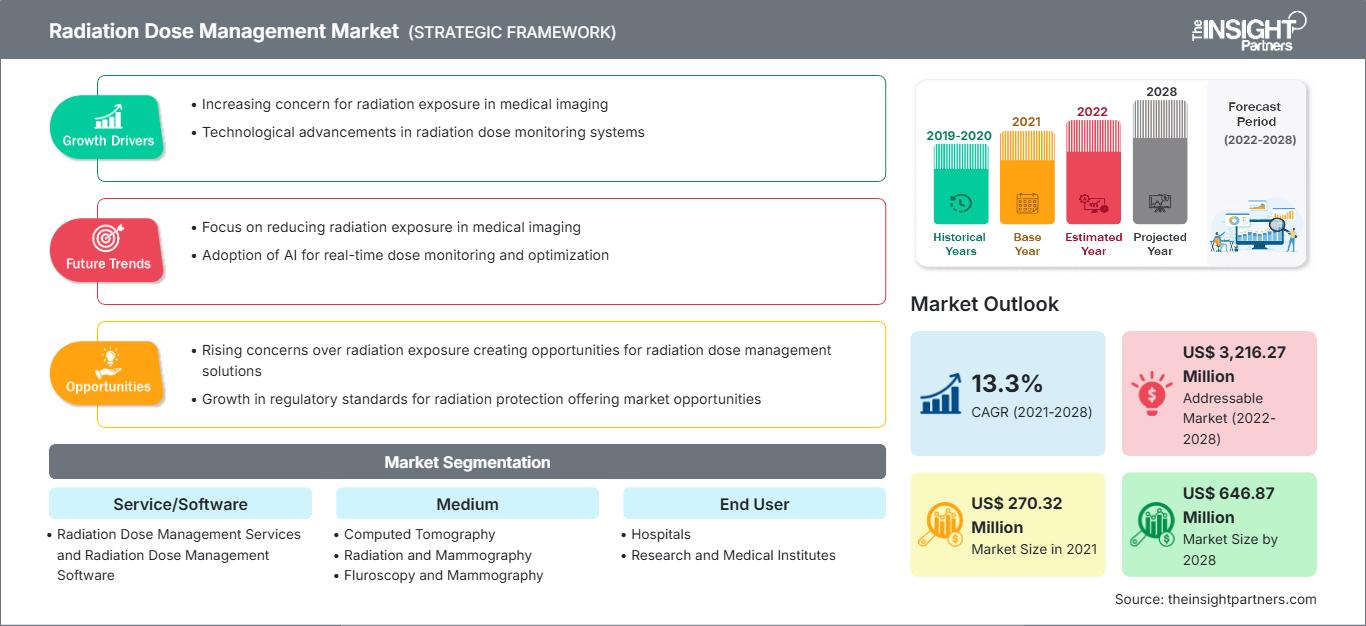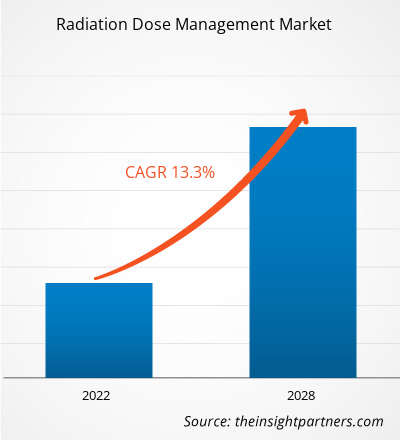Se prevé que el mercado de gestión de dosis de radiación alcance los 646,87 millones de dólares estadounidenses en 2028, frente a los 270,32 millones de dólares estadounidenses en 2021; se estima que crecerá a una tasa de crecimiento anual compuesta (TCAC) del 13,3 % durante el período 2021-2028.
La radioterapia es una rama esencial de la medicina. Diversas enfermedades, como el cáncer y las enfermedades cardiovasculares, se diagnostican y tratan mediante ondas electromagnéticas. Se utiliza ampliamente para tratar diferentes tipos de cáncer. Sin embargo, la radioterapia también tiene efectos secundarios. Por lo tanto, es fundamental controlar la dosis correcta de radiación en cualquier procedimiento médico que la utilice. La dosis de radiación es la cantidad de radiación que recibe el paciente. La gestión de la dosis de radiación comprende la información del software de registro de dosis; la monitorización de la dosis por parte del personal en tiempo real; el cumplimiento de la normativa; y las tecnologías de reducción de dosis, como el software de reconstrucción interactiva.
El crecimiento del mercado de gestión de dosis de radiación se atribuye a la creciente preocupación por la exposición a la radiación y al aumento de casos de cáncer que requieren radioterapia. Sin embargo, los desafíos organizativos y la falta de evaluación comparativa para la optimización de dosis dificultan el crecimiento del mercado.
Obtendrá personalización gratuita de cualquier informe, incluyendo partes de este informe, análisis a nivel de país y paquetes de datos de Excel. Además, podrá aprovechar excelentes ofertas y descuentos para empresas emergentes y universidades.
Mercado de gestión de dosis de radiación: Perspectivas estratégicas

-
Obtenga las principales tendencias clave del mercado que se describen en este informe.Esta muestra GRATUITA incluirá análisis de datos, que abarcarán desde tendencias de mercado hasta estimaciones y pronósticos.
Perspectivas del mercado
Mayor interés en la radiología intervencionista y la medicina nuclear
Los rápidos avances en tecnología médica, fabricación de dispositivos y equipos de imagen han permitido perfeccionar los procedimientos originales con mejores técnicas y ampliar sus indicaciones. Se han desarrollado nuevas técnicas y algunas se han adaptado a otras modalidades de imagen. Gracias a la alta eficiencia de la imagen, se realizan cada vez más procedimientos de radiología intervencionista y medicina nuclear en todo el mundo. Según la Sociedad de Medicina Nuclear, en Estados Unidos se realizan aproximadamente 20 millones de procedimientos de medicina nuclear al año. Tal como informa la Asociación Nuclear Mundial, más de 10 000 hospitales en todo el mundo utilizan radioisótopos en medicina y el 90 % de los procedimientos con radioisótopos son diagnósticos. Empresas como Bayer Healthcare y Sectra Medical Systems ofrecen software de gestión de dosis específico para la gestión de dosis de radioisótopos en imagen intervencionista y medicina nuclear. Por lo tanto, el creciente interés en la radiología intervencionista y la medicina nuclear ofrece oportunidades para el crecimiento del mercado.
Información basada en servicios/software
Según el tipo de servicio o software, el mercado global de gestión de dosis de radiación se ha segmentado en servicios y software de gestión de dosis de radiación. El segmento de software de gestión de dosis de radiación ostentó la mayor cuota de mercado en 2021 y se prevé que registre una tasa de crecimiento anual compuesta (TCAC) del 13,6 % durante el período de pronóstico.
Perspectivas basadas en medios
Según el medio utilizado, el mercado global de gestión de dosis de radiación se segmenta en tomografía computarizada, radioterapia y mamografía, fluoroscopia y mamografía, y otros medios. El segmento de tomografía computarizada ostentó la mayor cuota de mercado en 2021 y se prevé que registre una tasa de crecimiento anual compuesta (TCAC) del 13,8 % durante el período de pronóstico.
Perspectivas regionales del mercado de gestión de dosis de radiación
Los analistas de The Insight Partners han explicado en detalle las tendencias regionales y los factores que influyen en el mercado de la gestión de dosis de radiación durante el período de previsión. Esta sección también analiza los segmentos y la geografía del mercado de la gestión de dosis de radiación en Norteamérica, Europa, Asia Pacífico, Oriente Medio y África, y Sudamérica y Centroamérica.
Alcance del informe de mercado sobre la gestión de dosis de radiación
| Atributo del informe | Detalles |
|---|---|
| Tamaño del mercado en 2021 | US$ 270,32 millones |
| Tamaño del mercado para 2028 | 646,87 millones de dólares estadounidenses |
| Tasa de crecimiento anual compuesto global (2021 - 2028) | 13,3% |
| Datos históricos | 2019-2020 |
| período de previsión | 2022-2028 |
| Segmentos cubiertos |
Por servicio/software
|
| Regiones y países cubiertos |
América del norte
|
| Líderes del mercado y perfiles de empresas clave |
|
Densidad de los participantes en el mercado de gestión de dosis de radiación: comprensión de su impacto en la dinámica empresarial
El mercado de la gestión de dosis de radiación está creciendo rápidamente, impulsado por la creciente demanda de los usuarios finales debido a factores como la evolución de las preferencias de los consumidores, los avances tecnológicos y una mayor conciencia de los beneficios del producto. A medida que aumenta la demanda, las empresas amplían su oferta, innovan para satisfacer las necesidades de los consumidores y aprovechan las tendencias emergentes, lo que impulsa aún más el crecimiento del mercado.

- Obtenga una visión general de los principales actores del mercado de gestión de dosis de radiación.
Información basada en el usuario final
Según el usuario final, el mercado de gestión de dosis de radiación se segmenta en hospitales, institutos de investigación y médicos, y otros. El segmento hospitalario ostentó la mayor cuota de mercado en 2021 y se estima que registrará la mayor tasa de crecimiento anual compuesto (TCAC) del 13,6 % durante el período de previsión.
El lanzamiento y la aprobación de productos son estrategias comunes que adoptan las empresas para expandir su presencia global y su cartera de productos. Además, los actores del mercado de gestión de dosis de radiación se centran en la estrategia de alianzas para ampliar su clientela, lo que, a su vez, les permite mantener su marca a nivel mundial.
Perfiles de empresas
- Corporación FUJIFILM Holdings
- Bayer AG
- Bracco Imaging SpA
- GE Healthcare
- Koninklijke Philips NV
- Medsquare
- Corporación Novarad
- QAELUM INC
- Sectra AB
- PACSHealth, LLC
- Análisis histórico (2 años), año base, pronóstico (7 años) con CAGR
- Análisis PEST y FODA
- Tamaño del mercado, valor/volumen: global, regional y nacional
- Industria y panorama competitivo
- Conjunto de datos de Excel
Informes recientes
Informes relacionados
Testimonios
Razón para comprar
- Toma de decisiones informada
- Comprensión de la dinámica del mercado
- Análisis competitivo
- Información sobre clientes
- Pronósticos del mercado
- Mitigación de riesgos
- Planificación estratégica
- Justificación de la inversión
- Identificación de mercados emergentes
- Mejora de las estrategias de marketing
- Impulso de la eficiencia operativa
- Alineación con las tendencias regulatorias






















 Obtenga una muestra gratuita para - Mercado de gestión de dosis de radiación
Obtenga una muestra gratuita para - Mercado de gestión de dosis de radiación